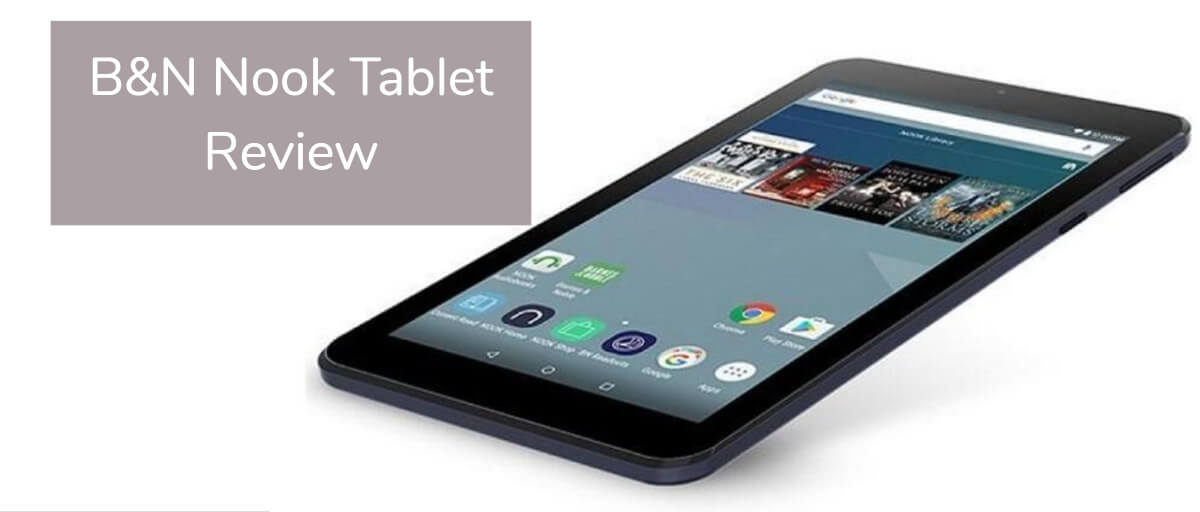Table of Contents
Last Updated on March 29, 2020
In 2011, Barnes and Noble made a play for the tablet market by releasing the Nook Tablet. Although when compared with their previous Nook, the Nook Color, the tablet holds its own.
Inside and Out
In portrait, the silver colored Nook Tablet measures 8.1 by 5-inches and 0.48-inches deep. It weighs 0.88 lbs / 0.40 kg. At that size and weight, it competes directly with the Kindle Fire.
The left side of the Nook Tablet hosts the volume buttons and the power button is on the upper right side. On the front is the home, or “n” button. On the back is the speaker. The back of the Nook tablet curves inward for easy gripping. The headphone jack is at the top of the tablet and the USB port is at the bottom.
Also at the bottom, in the corner is the microSD slot.
The Nook Tablet 8Gb has built-in Wi-Fi and runs off a 1 GHz dual-core processor with 512MB of Ram (16GB model features 1Gb of Ram).
The 7-inch multi-touch IPS display shows a resolution of 1024-by-600. In comparison to both the Nook Color and the Kindle Fire, the resolution is the same and so is the screen size. While not the best and brightest, images and video do look good on the Nook Tablet. Reading on the screen is a pleasant experience in itself.
Although there is a 16GB model, the 8Gb Tablet has enough space for most light use, especially since it is expandable with a microSD card (max. 32GB of additional storage). Additional storage capacity can be very useful, as Nook Tablet takes the majority of the space for OS and content downloaded from Barnes & Noble.
In case a lot of video and photo material will be stored on tablet, additional SD card is a must.
The Battery
Whereas e-ink readers like the original Nook could stay on for obscene amounts of time without charging, the Nook Tablet rates at up to 11 hours for reading and around 8 hours for video and other applications. Although many users have reported a shorter lifespan for heavy use, it is still enough to get you through a lot of video watching.
Software
The Nook Tablet uses a seriously customized version of Android 2.3. Out of the box, the Nook Tablet comes with a web browser, music player and media viewer for pictures and video. You will also have access to Netflix and Hulu as well as many other apps approved by Barnes & Noble like Pandora and a few games.
You will not have access to the full Google app store and many basic Android apps like Maps. However, there are alternatives, such as dual bootable 16GB or 32GB NR Cards and N2A – Nook to Android microSD Card, that can give some added functionality to both the Nook Color and the Nook Tablet
Nook as fully featured Android tablet
Dual boot Nook/Android cards are for those looking for more tablet-like functionality but without the wish to mess around trying to mod or root the Nook and possibly void the warranty. It is important to mention it here as it’s an option that adds a lot to a Nook device.
Nook to Android is a preformatted microSD card that loads a full version of Android, essentially making the Nook a fully functional Android tablet without removing any of the built-in features of the Nook itself.
It gives you access to the Android market and all of its thousands of apps. Just that by itself is enough to turn your Nook Tablet into a fully featured tablet device, as opposed to an e-reader with a few tablet functions.
Comparing the Nook Tablet to the Nook Color
It’s hard to talk about the Nook Tablet without talking about the Nook Color. You can look at the Nook Tablet as an upgraded version of the Nook Color. B&N did not change too much the design of the Nook Color when developing the Nook Tablet.
Physically, the two share the same dimensions, although the Nook Tablet is slightly lighter in weight. But with its faster dual-core processor and more storage space, the Nook Tablet is obviously the more powerful of the two.
Comparing the Nook Tablet to the Kindle Fire
The two devices have a strikingly similar feature sets. Strictly as e-reading devices, it will probably come down to if you want your books from Barnes and Noble or Amazon. As tablets, the edge probably goes to the Nook Tablet because of its ability to be tinkered with, modified or upgraded to a full Android tablet. Video also looks just a little better on the Nook.
The Kindle Fire also lacks expandable storage. On the other hand, Amazon offers faster cloud-accelerated browser and better media support. That may be enough to give many potential users something to think about before a purchase.
Bottom Line
People really like the Nook Tablet. As an e-reader, they find the device to be responsive, good on the eyes and truly enjoyable. As a tablet, people did not like the Nook interface and lack of apps. However, it was not a deal breaker. It’s also an issue that users with a little knowledge can correct with a little digging.

